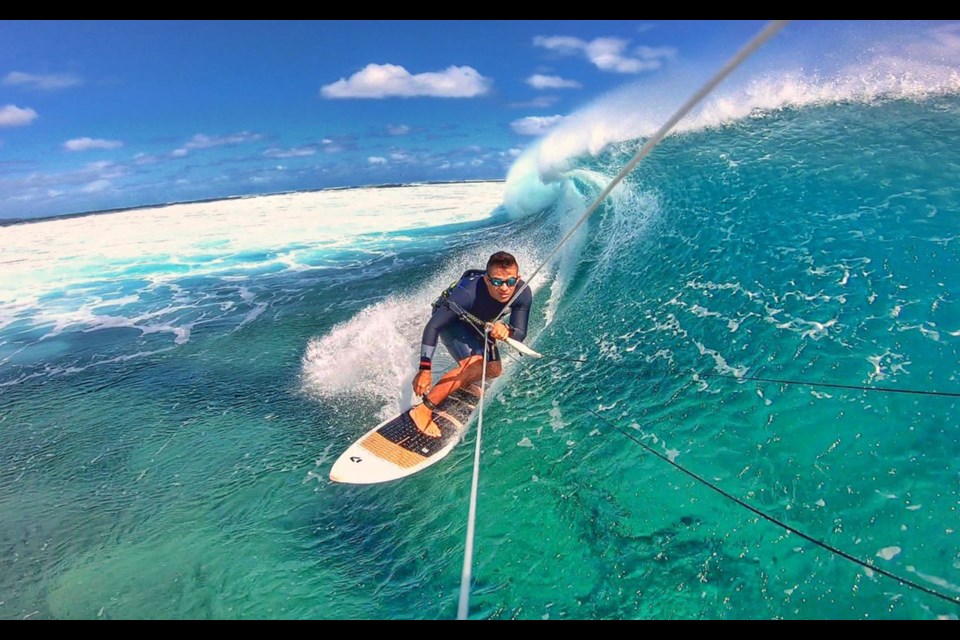Snowboarders may be carving up the slopes now with creative, crunchy cruisin’, but we can also dream about future cruises that offer different kinds of boarding that rely on water (in a liquid state) or the shifting sands of time.
Boarding fans know “’sup” isn’t just text talk for “What’s up?” SUP is an acronym for stand-up paddle-boarding, a popular sport beautifully suited for Whistler, with its lakes and rivers and views of the Coast Mountain Range.
SUP is also a wonderful sport to enjoy when travelling, to get new perspectives of different parts of the world (and to do so without wearing a mask when on the water). Personally, I have loved SUPing along a river to a cave in Puerto Rico, and along the fancy homes of Huntington Harbor in California, which is just across the Pacific Coast Highway from the famous surf boarding waves of Huntington Beach. In Puerto Rico, I saw flora and fauna I wouldn’t have otherwise. In California, I saw how other humans live—with yachts parked at the docks in front of their homes on man-made islands. You can even paddle up to a dock for a meal.
As a travel writer, I have loved paddling from a kayak with UNCRUISE in Alaska and the Sea of Cortez, Mexico. To be upstanding, they now offer SUP for their active passengers on cruises in Alaska, Hawaii, Pacific Northwest, and Belize.
“We host adventurers from ages eight to 99,” says president Dan Blanchard, “and while not all of them will paddleboard, there is still fun to be had as a spectator. We have plenty of first-time paddle boarders and feel that their desire for new experiences is enhanced and inspired by being outdoors!
“This is particularly felt during times of COVID-19 as more people explore remote places and new options for a bit of reprieve.”
Blanchard adds that UNCRUISE has “…experienced expedition guides to assist you right from the stern of the boat—keep watch, take photos, and even give you a bit of a lesson, if needed.”
Wave-catching, fishing from the board, and doing yoga on the board are all variations of paddle boarding in diverse places. When I was in the interior jungles of Papua New Guinea, I saw many people on the Sepik River standing in shallow long wooden boats using one long paddle. In an area where wheeled transportation wasn’t possible, they looked like they have been doing their own form of SUP for many generations.
“Modern” SUP credit is usually given to the Olympic gold-medal-winning Duke Kahanamoku and his pals in Hawaii as an adaptation of surf boarding. (Kahanamoku won multiple Olympic gold medals in swimming starting in 1912.)
For easy entry into the only boarding sport that is more popular than snowboarding (numbers-wise), a warm locale like Waikiki in Hawaii, where surfing became famous, is a memorable, easy place to learn. The water is warm, and the waves are gentle and long. The boards are long, also. Usually within the first lesson you can ride a wave, and wave your hand at Diamond Head in the distance.
If you are thinking of trying kiteboarding, a relatively easy place to start learning the challenges of both on the water and in the air is in Puerto Rico, a Caribbean island with English as the main language.
Years ago, on the white sands of Puerto Rico, I learned about the controls and was harnessed up with 15 Knots Kiteboarding School. I checked in recently with Juan Carlos Morales of 15 Knots who tells me they now use jet skis to accelerate learning. He also says the shop will re-open in December and be active until next fall, when the winds die down again.
Asked about the name of this school dedicated just to kiteboarding, Morales informed me that 15 knots is the average speed of the winds on Puerto Rico, and a great speed for gentle learning, and, “We just like the name!”
If you are looking for a place far from home to try windboarding (a.k.a. windsurfing), I can personally recommend the Caribbean Island of Bonaire where it is photographic, fun, and warm. I had enjoyed windboarding years before in Malibu, California but the waters were choppier, the winds more wily, and the water colder. I felt more competent in Bonaire (Not that the word competent belongs in the same sentence as “me” and “windboarding!”).
My most adventurous boarding so far has been ashboarding (a.k.a. volcano boarding) in Nicaragua, where the sport was invented. Walking up the fascinating blackened rubble of a volcano with steam venting out of nearby holes makes one feel as if the upcoming ride has truly been earned. There was a sitting option and a standing option. I sat and was still hooping and hollering on the way down!
Austin Adventures, which sponsored that Nicaragua trip, is currently adapting its projected trips around the globe in 2021 with COVID-19 safety in mind. The company also customizes trips. Dan Austin recently informed me that ashboarding in Nicaragua, and even sandboarding in the Sahara of Morocco, are not out of the question to add to an itinerary.
Let’s hope by the time the snows melt, more waters of the world are available with safe travel—and that you can even check out if there are some skills transfer from snowboarding to ashboarding or sandboarding.
Please share your bucket list boarding destinations as well as favourite kinds of boarding and best travel places for boarding in the comments section of the online version of this article—so we can all board well instead of being bored.
Lisa TE Sonne loves exploring and sharing places and people. Feel free to message her on LINKED IN at LisaTESonne or visit www.LisaSonne.org.




